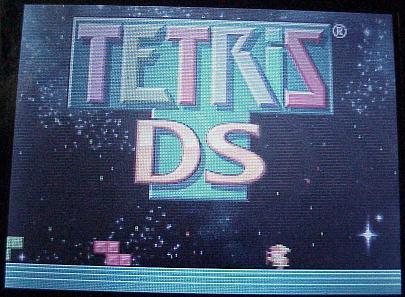

Tetris. There's a very good chance that every single person reading this has played Tetris in one form or another. From its innocent beginnings in the Arcade and on the Gameboy, to a massive phenomenon which has spanned over 20+ systems, more than 50 different games, and a whole host of spin-offs involving everything from Hats to Words to anything else one can imagine, and, if not "creating" the Puzzle genre of games, definitely being the major player in its popularity, Tetris is familiar to not only countless video game fans, but probably many people who wouldn't even consider themselves video game fans. Tetris spans generations, many different types of people, with different tastes and interests.
For anyone who hasn't played Tetris, the basic idea is simple enough. Pieces are dropping from above, and falling down. These pieces come in 6 basic shapes, of 4 pieces each: A straight line, a box, an "S" and "Z" piece, a forwards and backwards "L" piece and a "T" piece. Between where they enter the screen and where they come in contact with the bottom (or another piece) and stop, one can move and rotate the piece to get it into a position that one likes. At the bottom of the screen, one arranges these pieces with the goal of forming a solid line entirely across the screen. When such a line is formed, it's cleared and the pieces disappear, and the pieces above move down. If the stack of pieces reaches the top of the screen, the game is over. That's the basic idea of Tetris, which can be found in most any version out there, and is the central core that the game is based on. It sounds simple enough, but, like many things that sound simple, it can get very involved and addicting.
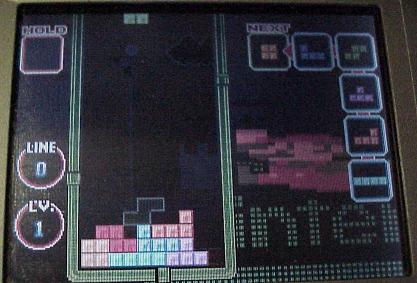
If you don't yet own a version of Tetris, and the basic idea of the game sounds interesting, definitely you should get going and check out one of the versions available. Probably the better question is, for the people who have many versions of Tetris already, what makes this version different? If one already owns a dozen versions of Tetris, why does one really need another? Likewise for the people who don't have any version of Tetris, why pick this one up as opposed to any of the other versions from the bargain bin? Why this version of Tetris, what sets it apart, and makes it worthwhile for purchase from among the other choices and selections?
Probably the key selling point of Tetris DS, the primary thing which for many is going to set is apart from the others, is one central thing: Wi-Fi play. Tetris, as is the case with many other Puzzle games, while very fun as a single-player game, really shines in its multiplayer mode. While playing Tetris by oneself is fun, playing it with others really opens the game up. Getting together either another person, or in some versions 3 or more other people, can lead to quite the enjoyable experience. While playing against a computer is fun, there's just something different about playing against a real person, something that still can't be fully covered by a computer. One doesn't, however, always have people handy to play against.
Beyond that though, the game itself is important too, of course. After all, simply being able to play a game online isn't important if a game isn't good. Likewise, if one isn't interested in that, or one has people around to play with, or one doesn't have access to a connection, or whatever other reason one might have, simply saying "Hey, it's Tetris with WiFi! Go buy it!" isn't guaranteed to be enough for everyone. So, beyond that key point, what does Tetris DS have to offer? What significance does it have when compared to other Tetris games that one might already have or consider buying, which would make it worthwhile in comparison to them?
There are a few changes to the core Tetris game which may or may not be familiar depending on which versions of the game one has previously played. The first is the "hold piece." This small box up in the corner (which starts off empty), can be used to store a piece. As your pieces come up and start dropping, if you don't like a piece, or want to save it for later, or whatever the case may be, you simply press a button and it goes up into that box. Later, if you decide you want to use it, or come across another piece that you don't have a good place for, you can press the button again, and the piece in the box will be brought out and the piece that had been falling will go in. While at first it may seem like this would make the game much easier (and it does to an extent), it also brings in an element of strategy, deciding when and how one desires to use certain pieces. The other change, not quite as major but still significant, is that, off to the side, where in other Tetris games you'd usually simply see the next piece due to fall, in this game you see the next six pieces that will come. Again, this gives you more of a chance to plan and form a strategy with the pieces.

When one begins playing in any of the modes, one of the first thing that's going to really jump out, is the strong Mario theme to the game. Of course, we've seen the Tetris name in a game with a Mario theme before with Tetris Attack. That, though, was a rather different type of game (actually a completely separate series). So, here we have the standard Tetris sort of game, infused with Mario. Often they don't really have much to do with the actual gameplay, but instead are simply some side entertainment while one is playing. For instance, in the standard "Marathon" mode of Tetris, on the bottom screen one has their standard Tetris field, the rectangle with pieces dropping down. In the background of this, however, is a little scene from Super Mario Bros. 1 with Mario by a flagpole at the castle. Off to the right side is a big image of Mario jumping (just for decoration).
The real "action" of the Mario involvement takes place on the top screen. Here, you have a computer-controlled Mario actually playing through the first level of Super Mario Bros. 1. As you play Tetris, each time you clear a line, Mario continues along the stage, stomping Goombas, jumping over holes, and all his usual tricks. Eventually (assuming you don't lose), he'll reach the end of his level. As you continue along, gaining levels in Tetris, eventually Mario will switch over to a game of Super Mario Bros. 3, and begin playing that. Without going through telling about all of the different levels, the basic idea is, the longer you stay alive in Tetris, the further Mario is going to make it in his various journeys at the top. Also, depending on the mode, level, speed, and other factors, one will have different backgrounds behind the screen, and different levels that Mario is working his way through. While you're playing your game of Tetris, for your background music, you actually have the music of the Mario game that's being played above playing. So, the two things do blend together to a certain extent as well. Of course, after a while one can't really take time away from playing Tetris to look up and watch Mario. The pieces are coming too fast to pay attention to stuff like that. Still, it's an interesting diversion.
The Standard modes that one has to choose from are Marathon, Line Clear, and Vs. CPU. Marathon (as partly described above) is your basic Tetris mode. Pieces drop, you keep clearing them, and, as long as you don't die, you continue on for quite a while. Initially you have a "line goal" to meet, and then once you do that, you can choose a mode to continue on as long as you want. Then, there's the Line Clear mode. Here, one chooses a Level (the speed) and a Height (the amount of "junk" pieces at the bottom of the screen to start with), and your goal is to clear 25 lines without dying. The Vs. CPU mode is you playing a game of Tetris against a computer-controlled player. Here, the goal is to be the last one alive. Clearing multiple lines will send junk pieces up to the computer player, making things more difficult for them. It's pretty much the same as playing with a person, just, without the actual person, and the computer instead.
Beyond the Standard modes, there are a number of other modes which are new and unique to this game, and really serve to set it apart: Push, Touch, Puzzle, Mission and Catch.
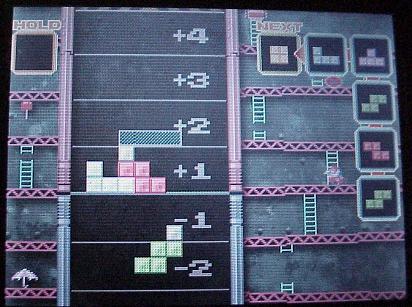
In Push mode, the top screen finally starts to come into real use with the gameplay. Push is a 2-player game, which can either be played versus the computer or over the WiFi (more on that later). In it, one player (you) are on the top screen, while the other player is on the bottom screen. Instead of dropping pieces "down toward the bottom," you're both essentially competing for the middle ground. Pieces form at the middle, with yours on top and your opponent's underneath. Clearing a line across causes the "middle line" to move down toward your opponent's field. When they clear a line, the middle line moves back up toward yours. Needless to say, as the "middle line" gets closer to the top of your screen, it gets much more difficult to manage your pieces. Like in normal Tetris, if the stack reaches the top that player loses. Just, the fact that where one is placing the pieces is moving around definitely creates a very different feel. This actually takes a decent amount of time to get used to, as the idea of the place where you're putting the pieces actually changing around (and having other pieces underneath it) is rather awkward at first. Still, once one gets used to it, it's a pretty nifty mode, and is fun to play against others.
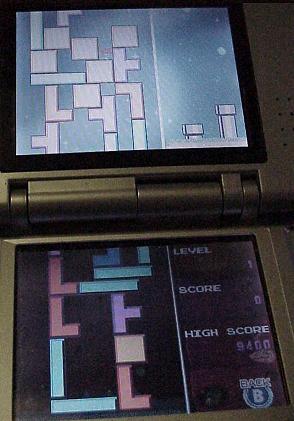
The Touch mode has two settings: Tower and Touch Puzzle. Here, you're greeted by characters and music from the game Balloon Fight. In Tower mode, you start off with a pile of very big Tetris pieces (in the usual shapes, just, bigger than the usual), with a box of balloons at the top. The pile starts on the bottom touch screen, and extends up to the top screen and over. Here, the goal is to use the stylus on the bottom screen to drag and rotate the various pieces around. As you move the pieces, if holes open, pieces from above will drop down. If you form a line across the screen, it will clear and everything above will drop down. Of course, the problem is, you can only rotate a piece if there's space to rotate it, and if there isn't you can't move the piece there. So, you'll have to slide pieces and move them around, getting things into good order, so that you can rotate and move other pieces to get them where you want. Eventually, the pile will get low enough and enough spaces will open where you can drop the box of balloons to the bottom and win. There are a number of different levels to choose from in this mode, and, in the higher levels, you actually can't rotate the pieces at all, instead being limited to only sliding them around. Needless to say, things can get very difficult.
In the Touch Puzzle mode, you have a choice of 50 different puzzles to choose from. Here, like modes 4 and 5 in the Tower mode, you're not allowed to rotate the pieces, only slide them around. At the top of the screen in each puzzle, you're given a goal to accomplish, such as "clear a 2-line chain," or "clear 3 lines at once," or a more difficult one such as "clear all the blocks with a 6-line chain." On the bottom screen, you're given an arrangement of big pieces, and you have to slide them around in order to accomplish the goal you've been given. Not being able to rotate the pieces actually makes things a bit easier, as you only have to worry about sliding them around, so it gives one less thing to worry about. Still, many of the puzzles get very challenging, and are fun to play around with. Of course, eventually one will run out of puzzles, but, even after one has completed them all, they're still fun to go back through and figure out again.
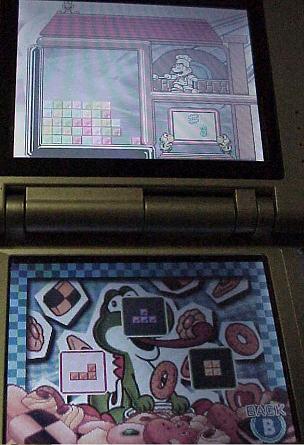
In Puzzle mode, presented with a Yoshi's Cookie style screen and music, your goal is to clear a screen full of junk pieces on the top screen with only a certain selection of normal pieces on the bottom. There are two main catches when trying to solve this mode: You have to clear at least one line with each piece you drop, and, you can't choose where the piece is actually dropped. You select the piece on the bottom screen, rotate it to get it into the position you want, and then select it again to drop it. Where the piece is dropped is determined automatically by where it's "supposed" to drop. On one hand, again, this gives one less thing to worry about. On the other hand, it gives no indication of where the piece is going to drop until you select it, so, the first few moves of each puzzle are often just figuring out what the pieces are going to do. This mode does feel rather more awkward and stiff than it might have otherwise, but, after a bit of time, it does flow a bit more smoothly. Here, you have a total of 200 different puzzles to choose from. So, it will definitely occupy a good amount of time to solve them all.
The Mission mode is played similar to Standard Tetris, except that you're given goals to accomplish as you play. You can choose from either Marathon mode, where you continue on as long as you can until you lose, or Time Trial mode where you see how many missions you can accomplish in a given time. As you begin playing, a goal will come up, such as "Clear 3 lines at once." Play takes place on the bottom screen, while on the top screen it will show an example of what it desires you to do. The presentation here is with a Legend of Zelda style, with Link off to the side, the waterfall from the start screen on the top, and a scene from the game in the background. More importantly, off to the side you have a "heart meter" similar to the one in Zelda 1. As you're playing, if you're taking too long to accomplish the goal, the hearts will slowly become empty. If all of your hearts become empty, you'll lose. As you accomplish a mission, the hearts will fill back up and some of the pieces on your screen will go away, keeping things from getting too high. In Time Trial mode, of course, the game is also over once your overall timer meter runs out as well. This really is a rather fascinating take on the standard Tetris mode, and is extremely fun for just playing around, but with more of a directed goal to things.
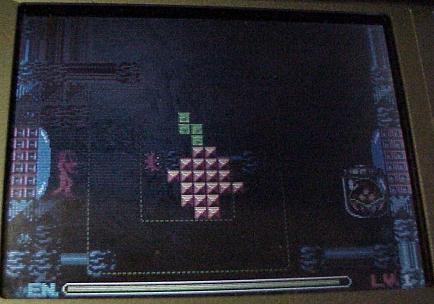
The last Single-Player mode is Catch. Here, in a stage set with a Metroid theme, on the bottom screen you start off with a single block in the middle of the screen. Your goal is to take the Tetris pieces that come floating down from the top, and assemble them around this core block to form bigger squares, within the dotted square patterns that are displayed. You can move the central core (which, as you build pieces around it, will get much bigger) back and forth around anywhere on the bottom screen. You can rotate the core on the bottom, but, can't change the way the pieces from the top are falling. As you're playing, the background screen will slowly be scrolling down, and with it enemies will also be coming along. When your core forms into bigger blocks, the new block will turn white and you'll have a chance to set off an explosion. The explosion will go off in all four directions from where your central block is, and destroy any enemies which are in its path. As you destroy enemies and get points, you'll move up in levels. If your block comes into contact with one of the enemies, you'll lose health from a health meter at the bottom.
That describes all of the different single-player modes that one has at their disposal. Some very different and interesting takes on the core Tetris game, which definitely are very interesting to play around with, and could easily take up a good amount of time and play on their own. To this point though, what is probably the main draw of this game, the Multiplayer and Wi-Fi modes, haven't even been discussed. While all the different new modes are very interesting, this really is the heart of this new Tetris game, and what is really what sets it apart.
For the regular Multiplayer mode, you have three of the modes described above to choose from: Standard, Mission and Push. In Standard mode, you and up to 9 other friends can connect to play a game of Tetris. One of the best things about this mode (and something that was sorely lacking from the GBA version of Tetris), is that, in order to play, you only need One copy of Tetris DS. All you need to play Tetris with a room full of friends is a group of people who only have a DS system, and your own copy of Tetris DS. Set up the Download Play mode, get everyone ready and you're good to go. This makes setting up a game of Tetris quick, simple, and completely hassle-free. As long as everyone has their DS with them, any time you're in the mood for Tetris, you're all set and prepared. This is an absolutely brilliant addition to a Tetris game, and, even on its own would easily set this game apart as spectacular. From the Settings menu, you can adjust various things such as whether or not the game uses items, set a handicap, or arrange the players into teams to compete in groups. Beyond the normal Standard mode, you can also work through the Mission mode, competing against ten other players to see who can make it the furthest. Then, the last choice is competing in the Push mode against one other player to push them off the screen.
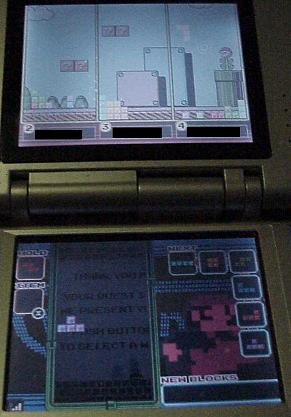
Then, there's the Wi-Fi mode. In order to play this, you either need to have a compatible wireless router, or a Nintendo Wi-Fi USB Adapter. Whether you've set up your connection for a previous Wi-Fi game already and only need to set up the game, or if you need to set up the connection as well, setting things up is very quick and painless, and within a short amount of time you'll be ready. From the main screen, you can enter in any Friend Codes of people that you know, in order to save them on your Friend Roster, where you can then view your Roster to see who is on it. People you haven't connected with yet the roster will only show their code. Once you've connected and played against a person, their Username will be displayed on your roster. After getting anything here set up, and within range of a wireless connection, you then connect to the Wi-Fi Battle mode.
Once connected, you're presented with three options: Worldwide, Invite Friends, and Join a Friend. If one of your friends is currently hosting a game, your Invite a Friend selection will be blinking with a little indicator next to it, so that you'll know right away if a friend is ready to play without even needing to check. If no friends are hosting and you want to host and wait for a friend, you can go to Invite a Friend mode, choose a game type and wait for one of your friends to come on and go looking. Otherwise, you can choose to just search for any players from the Worldwide option. The modes you have to choose from here are: Standard 2-player with no items, Standard 4-player with items, and Push mode. Once you choose this, the game will then search for other players looking for the same thing, and match you up. Again, a very quick and easy process, just a matter of waiting for the game to find the players, and then you can begin playing.
The Worldwide mode also comes with a Points system. When you begin, you start with 5000 points. In 2-player modes, winning will send the points up while losing will bring it down. In the 4-player mode, the exact point amount will be determined by where you finish in the game. If someone disconnects during the middle of the game, that's the same as losing, and their points will be affected by it. A bit annoying if one's connection does legitimately freeze or something, but, definitely a welcome addition to deal with people who would play until it looked like they were going to lose, and then exit just to preserve their record. Points are only determined by Worldwide gameplay as well, Friend Battles don't factor into the point totals. So, you can play as much with friends that you know without the worry of your points being determined by it, and then connect to Worldwide and work on that point total. As an added bonus, there is also an online leaderboard where people's point totals are displayed, either for easy reference or to share and show to others. You can also check your exact record (wins and losses and what places you finished) in the Records menu in the game.
All of this glowing review aside, there are a few minor issues to note with this game. The first is that the game has an "infinite rotation" problem. Without going into details, this basically allows a person to rotate (and move) certain pieces in certain situations across blocks at the bottom of the screen. This can be used either to avoid dying (one could, theoretically, keep doing this forever), or to slide a piece across the bottom to the space one wanted it. While it can't be done in every situation or with every piece, it's easy and common enough to be able to do where it can have a significant effect on gameplay. Of course, in Multiplayer, if while they're doing that you send them a bunch of garbage, whenever they do get around to placing the piece it won't save them from that. Still though, it is a rather unfortunate thing to have in there.
Then, there are a few minor issues to note with the Wi-Fi mode. First, while you can pick from either the 4-player or 2-player game, you're forced either to use items (in 4-player) or not use items (in 2-player). If one would like to play a 4-player game without items, or a 2-player game with items, that's not an option. Of course, it does make things simpler for matching people up, reducing the types of games that one would be searching for by two which serves to make for more people searching for the same thing. Still, it would've been nice to have the option. Also, there is no 3-player mode at all. It's understandable why, especially from the Points view: Finishing 3rd in a 3-player game is obviously different from finishing 3rd in a 4-player game. Also, again, it makes matching in Worldwide easier because you have people searching for fewer things. In a Friends match though, it would've been nice to have a 3-player option. Since, it's not always easy to get 4 friends online together at the same time, and sometimes one would just like to play with 3. As it is now, starting a 4-player game with 3 players is impossible, and so you'd just have to take turns playing 2-player games or something. Also, an issue with 4-player mode in Worldwide is, if a player drops during a game, at the end of the game it exits everyone out of the game since there are no longer 4 players. A better option would seem to simply keep the group of 3 intact and search for a 4th player (perhaps even while the game is in progress if the player drops during the game, so as soon as one game is over, it's ready to go for the next). Again, not a major issue, just a small hassle that could've been handled differently.
There would only be a few minor qualifiers to put in before absolutely recommending this game. First, if one is only interested in just the basic core Tetris game with nothing else, one might be better served either by the NES version, Tetris DX for GBC, or The New Tetris for N64. Further, if one doesn't have a problem getting friends together in one place, or would like to play with friends who don't have a DS, The New Tetris (which has a 4-player mode) would be the recommended version there. Also in favor of The New Tetris, as opposed to just keeping track of high scores like Tetris DS, The New Tetris also keeps track of total line count, with various "goals" to unlock by accumulating total lines (into the hundreds of thousands, so, it'll keep you busy for quite a while). So, if one isn't interested in the new modes, or the DS download play, or the Wi-Fi, then one could definitely make a case for The New Tetris for N64 still being the game to pick up for the other portions.
The minor nit-picking aside, in the end, Tetris DS is an absolutely spectacular game. The core Tetris is, of course, as much fun as it's always been. Of course, if one doesn't like Tetris to begin with, this game isn't going to change your opinion of it. If one does like Tetris, however, the new modes the game adds are very fun to play around with. Then, of course, the Multiplayer and Wi-Fi modes are both wonderful additions to the game. The Mario theme and aspects work into the game very well, adding some new elements and style to things.
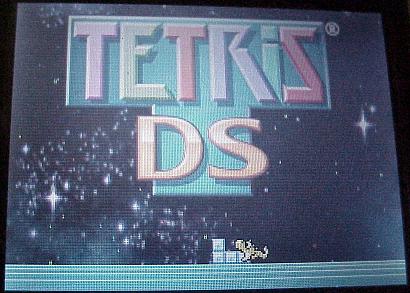
So, if one thinks the new modes sound at all interesting, or has friends who have DSs and would like to play with them, or especially if one has access to the Wi-Fi mode and would like others to play with through that, this is definitely a must-purchase. The core Tetris game is there, and is just as spectacular game as always. The new modes, especially the Puzzle modes and the Mission mode, really bring something new and interesting to the central format, making it worth checking out even if one is only interested in the single-player aspect of it. Beyond that, if one has been looking for a way to quickly set up a game of Tetris with many friends with little hassle, or has been looking for a way to play against other people when friends aren't always available, Tetris DS is like a dream come true. For anyone who loves Tetris, and wants something new to play around with, and a way to make Multiplayer even easier, this is definitely the version to check out.
Core Gameplay: 10/10
Single-Player Additions: 8/10
Multiplayer/Wi-Fi: 9/10
Graphics/Sound: 9/10
Length/Replay: 10/10
Overall: 10/10